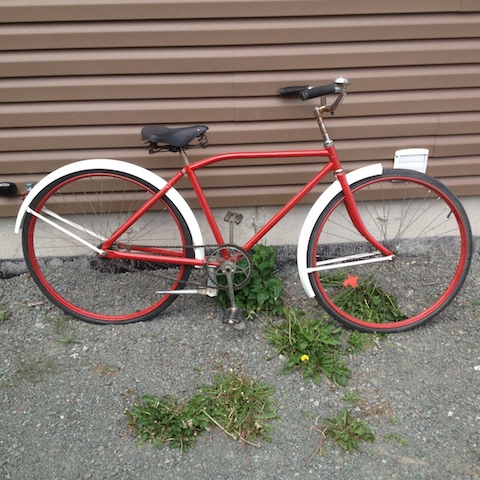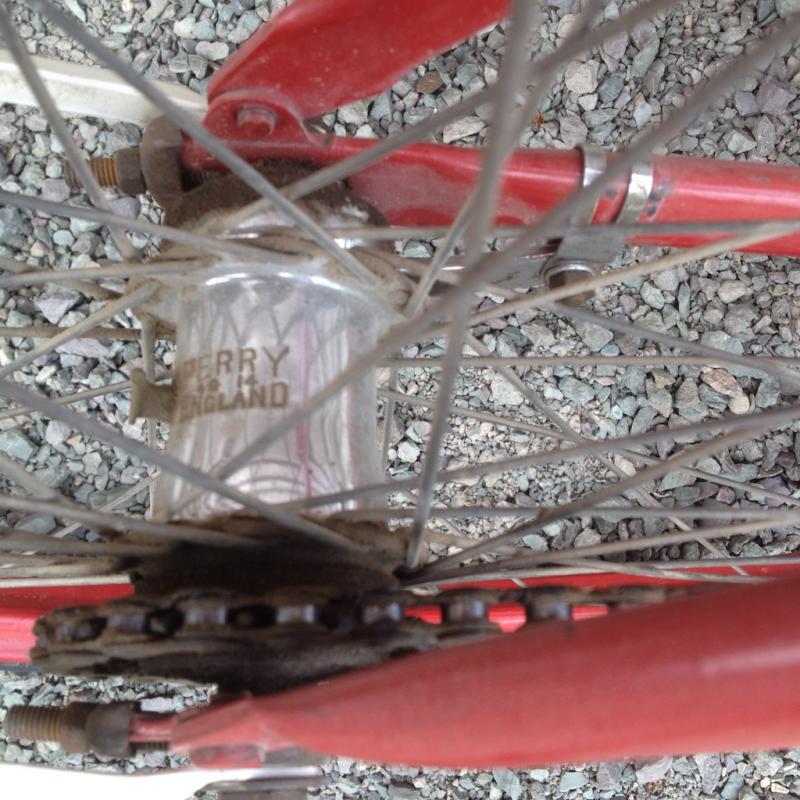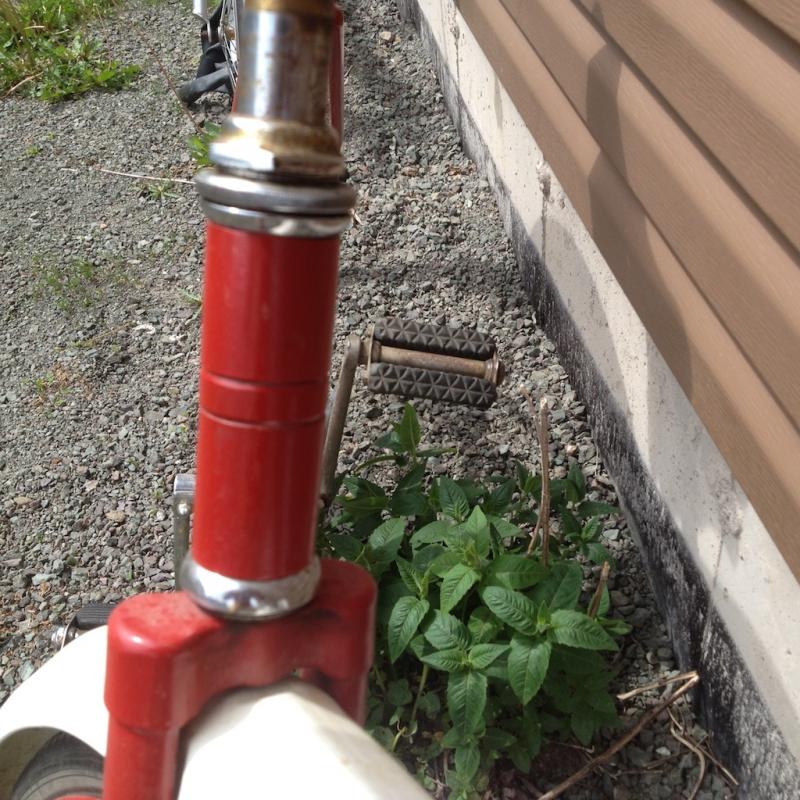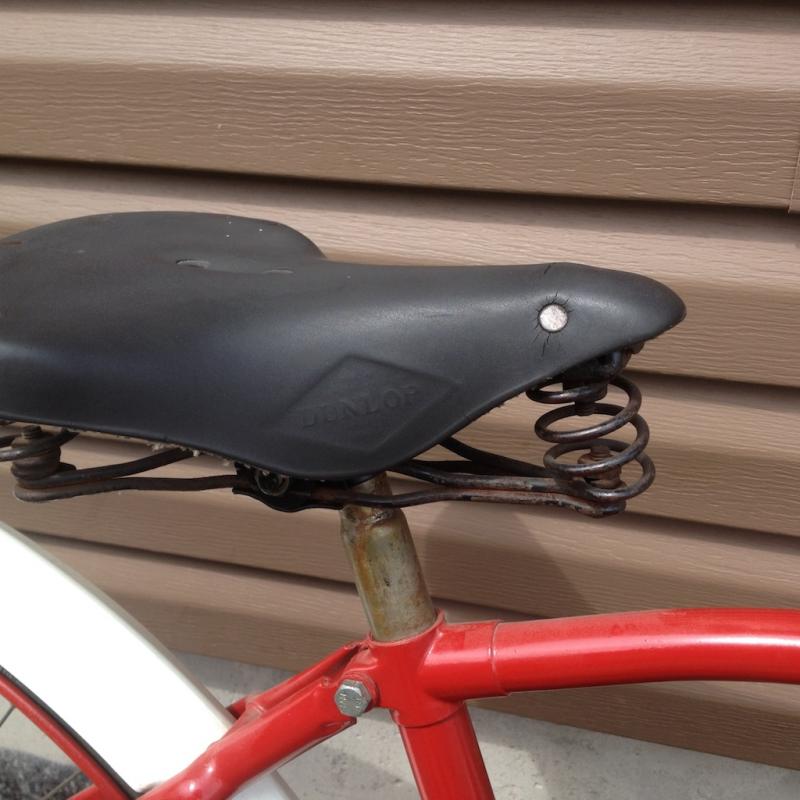Year, model and Head Badge?
Hi,
I acquired this "restored", what I think is a CCM as is, without a head badge. It has a Perry (Made in England) hub with the markings "40 14" (1940?). It has an original(?) Dunlop sprung saddle.
It has been painted but lacks a head badge. I would like to find out the model an approximate year if possible and where I might find a head badge or replica for the bicycle.
Also thinking about flipping the bars and making a path racer...any thoughts?
Thanks and take care,
Daryl









Looking at the chainwheel design, it might be a Canadian Tire Supercycle. It's hard to judge the size from the photo, but if it's small it might be a boy's model, especially if it has 26" tires. I will attach a photo of the chainwheel of my 1947 Supercycle.
Thanks Brain,
The top tube had me thinking it was a CCM. I guess that design is not specific to CCM. Th chain rings look identical. This is a 28" wheeled bicycle. So probably 40's. Thanks for the info.
Take care,
Daryl
The top tube on mine is the same. Search this site for the forum 1930's?? Supercycle Twin Bar and you will see photos of 3 examples including mine. On mine the front hub was made in England and the rear brake hub was made in the U.S. Your English brake is likely explained by a different year and supplier. -B.
In this case the 40 14 marking on the hub could indicate spoke count and gauge, as it appears to be a 40 hole rim.
Thanks Everyone,
Brian, your thread on your SuperCycle was very interesting and informative. I am amazed at the depth of information there is about a bicycle that is many decades old. I really liked reading T-Mars explanation on sourcing lugs/parts for CCM and other brands. Very cool.
It is a 40 spoke wheel and the serial number is 36885 stamped on the non-drive side of the seat clamp/lug. I noticed there was no chain guard on any of these models. I assumed mine was missing. I find the two horizonal lines in the head tube unique. I can see it one one of the examples and all have the same chain wheel design, so I can be reasonably sure it is a SuperCycle (?).
Is the term "motorbike" used synomously with "motorcycle" or were these motorbikes bicycles will small engines attached?
So is there any other features that may allow me to zero in on a date. Was there a model name asociated with these bicycles? Does the Perry hub give me any direction as to age?
And also, I noticed mention of "A handy thing for a Canadian trying to restore an old Sports is that the Gliders have the same Raleigh proprietary threading on the bottom bracket and headset (26 tpi). Of course, this also means an old Sports can be used to revive a Glider." I have a 1976 Made in Canada Raleigh Superbe (R serial number) that I was asked to restore. The other Raleighs I have worked on had 24tpi BB threads. How common was the 26tpi threads?
Thanks again everyone,
Take care,
Daryl
Motorbike or Motobike is generic term applied to bicycles with two top tubes as it mimics the early motorcycle frames where the gas tank was positioned between the top tubes. There are some other features common to Motobikes, such as the truss forks and handlebars with long rearward extension and crossbrace, but the double top tubes are the prominent feature and can't be swapped out, unlike handlebars or a fork.
I wouldn't consider this to be a Supercycle based soley on the crankset, as the design was not proprietary to Supercycle.
A completey numeric serial number would be found on pre-1921 CCM models but this does not appear to be one, though I have no idea what it may be.
Are there any markings on the brake arm of the Perry hub which might provide a clue to the date?
According to my references Raleigh stated using 26 TPI in 1963. However, it was only uised on the entry level (i.e hi-tensile steel), Nottingham built frames. The upscale (i.e. Reynolds 531) frames were built by Carlton and used the standard 24 TPI. Raleigh opened a Canadian factory in the early 1970s but I'm not sure which standard they used. Reportedly, another way to tell the difference is by measuring the width of the bottom bracket shell itself. 68mm shells typically use 24TPI threading, while 71 and 76 shells are typically 26TPI.
Hi,
Thanks for the info on the motorbike designation. There is the on the perry brake arm other than the name and a star. The tires are "Super-lastic" and "Made in Canada for Canadian Tire Corporation". Oher than that the bicycle isn't telling me much. It did have a riveted head badge at one time.
Since you mentioned it, I am begining to see this design of crank everywhere.
So far all the Raleighs I've worked were Made in Canada and had 24 tpi, but it is good to keep in the back of one's mind incase I encounter something other.
Thanks agian,
Daryl
should read "There is nothing on the perry brake..."
Daryl, the crankset looks a lot a Williams, specifically an F100, which was quite common from the 1930s to the 1960s. If so, there will be a Williams logo stramped on the back of the arms and/or chainring. The logo looks like dagger (I believe it's supposed to be sword but the blade is very short) with the letters E B W. Below the hilt will be a date code consisting of one or two alpha characters, At least it will help narrow down the year.
Daryl, here's what the logo looks like. In this case, the Y is the date code.
Hi T-Mar,
The crank is a Brampton (Made in England) stamped at the rounded end of the axle end of the crank arm.
I also noted that the stays have a semi-circle profile to them. Not something I recall seeing before. Not round or oval but flat on the wheel side of the tubing. The fender/brake cross piece looks nicely welded. It almost looks "inserted" in the two seat stays.
The other question I have is whether they ever used wax as a bearing retainer. I just took apart the BB and it looked like the picture. If it is grease, it is clean and hard, looking brittle at this point. Just wondering.
Take care, Daryl
That grease has just lost most of its oil. Grease is basically an oil and soap mixture, so once all the oil has disappeared, it cakes/hardens.
Thxs for the additional pictures. Unfortunately, they don't help, at least in my case. I had hoped the crankset would turn out to be Williams, in which case we would at least have a very good idea of the year.
Given all the British parts, it could also be a British brand, though typically they weren't as fond of camelbacl top tubes. The rims appear to be the Westwood style with rounded sidewalls. You say they are 28". The Canadian 28" rims and tires are smaller than the British. Canada used F.13 rims, with a 634mm outer diameter, almost exclusively. Alternately, the British heavily favoured the F10/F25.0 rims with a 849mm outer diamemter or the F5 rim which had a 654mm outer diameter. The rims may be marked with the F-designations or you can measure their outer diameters. If you can determine which version of 28*', you at least have a very good idea if it was Britrish or Canadian manufacture.
Hi T-Mar,
Thanks for the info. The hardened grease question is one I long sought an answer for!
The rims are F13's (622 tires) Westwoods. So learning towards a Canadian Build?
Take Care, Daryl
It's really hard to say. The F13 rims could indicate Canadian manufacture or manufactured for the Canadian market. However, given the repaint there's also the possibility that they are replacement wheels. Still, I'd lean towards the former. FYI, there is a typo in previous post. 849mm should be 649mm.
Ok. Thanks. I guess withut more to go on it will remain a bit of an uncertainity.
Thanks again and take care,
Daryl
Just a little more info on Perry hubs. You were correct about hub stamp:
"All Perry hubs feature a "xx-yy" stamp on the shell which designates the number of holes and spoke gauge for that shell (in this case 36-13)."
from:
http://rmalverson.blogspot.ca/2012/01/perry-coaster-hub.html
Cheers, Daryl
Here is another bike with the same chainwheel design, and it's made in Canada. The brand name is Leader? by Victoria Precision (something) co. ltd, of Montreal Canada? I've never heard of it. Dependng on which decades they were in business, maybe they could be the maker of the Supercycle and mysterious red bike discussed above?
Thanks Brian.
That chain wheel design keeps popping up everywhere now that I've noticed it. It seems to me it was widely distributed.
I restored a bicycle that had the Precision name not long ago. I wounder if they were built under that name as well as Leader. I knew nothing of its origin. It turned out to be quite a nice frame and bicycle when finished.
Take care, Daryl
I have the same chain wheel on my Royal Flyer
Nice Bike! I am not familiar with the make/model. Is it British? Seems these chain wheels are found on a lot of different brands spanning many years. Thinking they must be from a (one-time) well-established British manufcaturer. Thanks for the reply. Daryl